
HOME
INTRO
SYMBOLS
ALMANAC
ECONOMY
GEOGRAPHY
STATE MAPS
PEOPLE
FORUM
NEWS
COOL SCHOOLS
STATE QUIZ
STATE LINKS
BOOK STORE
MARKETPLACE
NETSTATE.STORE
NETSTATE.MALL
GUESTBOOK
CONTACT US


Tweet
Double click any word in document for definition.
Lone Star State Dinosaur
When is the state dinosaur not the state dinosaur?
In 1997 the Brachiosaur Sauropod, Pleurocoelus, became the official Lone Star State Dinosaur when Governor George W. Bush signed Senate Councurrent Resolution No. 57 on June 3, 1997.
S.C.R. No. 57
SENATE CONCURRENT RESOLUTION
WHEREAS, Texas has become world famous for its many dinosaur discoveries and for many of its unique dinosaur specimens such as the Pleurocoelus; and
WHEREAS, When the sea submerged the Antlers and the Paluxy formations, it put an end to dinosaurs in this region of the earth known as Texas for nearly five million years, approximately 105 to 100 million years ago; and
WHEREAS, There was an interruption in North America's geographic history caused by the expansion of the sea 100 million years ago, creating the Western Interior Sea Way which joined the Gulf of Mexico with the Arctic Ocean, thereby essentially splitting North America into two halves and remaining that way until very near the end of the Age of Dinosaurs, about 66 million years ago; and
WHEREAS, Several formations were laid down in Central Texas during that interval of marine time, fossilizing the remains of the 65 to 70 foot creature known as Pleurocoelus; and
WHEREAS, Today the footprints of Pleurocoelus created so long ago are visible once more, as featured in the Fort Worth Museum of Science and History's exhibition, Lone Star Dinosaurs; and
WHEREAS, Sauropods, specifically the species Pleurocoelus, inhabited the earth approximately 65 to 200 million years ago, then died out, leaving the footprints and bones in rock as young as 105 million years old, preserving this creature's prevalence in and across the State of Texas, causing the trackway left in Glen Rose, and making this site world famous; and
WHEREAS, All Pleurocoelus disappeared from North America for 35 to 40 million years, then reappeared, returning to what is referred to as the second dinosaur world in the heart of Texas; and
WHEREAS, Brachiosaur tracks are clearly the footprints of the species Pleurocoelus, large Quadrupedal Sauropod; they are responsible for not only the tracks in the Glen Rose region but those scattered across Texas; and
WHEREAS, Because the Pleurocoelus tracks and bone are found mainly in Texas and a small portion of Southeastern New Mexico, this species and its remains are the last major grouping of the Pleurocoelus, are indigenous to Texas, and are world famous; and
WHEREAS, The important locality referred to as the Jones site excavation of the Pleurocoelus is the biggest dinosaur project undertaken in the State of Texas led by the Fort Worth Museum of Science and History; and
WHEREAS, These discoveries combined with the leadership of the Fort Worth Museum of Science and History in the field of dinosaur research make the Pleurocoelus an ideal candidate to be the Lone Star State Dinosaur; now, therefore, be it
RESOLVED, That the 75th Legislature of the State of Texas hereby name the Brachiosaur Sauropod, Pleurocoelus, the official Lone Star State Dinosaur.
Pleurocoeus reigned for seven years before being dethroned by the work of a Southern Methodist University graduate student.
The fossilized bones thought to be Pleurocoelus were identified, instead, as a new species by SMU graduate student Peter Rose. The new species, Paluxysaurus jonesi, was named by Rose for the the town of Paluxy and the Paluxy River and the Jones Ranch where the fossils were discovered.
Rose's findings were published in 2007 and have been widely accepted by other scientists. [ A New Titanosauriform Sauropod (Dinosauria: Saurischia) From the Early Cretaceous of Central Texas and its Phylogenetic Relationships, by Peter J. Rose ]
Backed by the Fort Worth Museum of Science and History, the erroneous promotion of Pleurocoelus as the official lone star state dinasour was put on the road to correction by the introduction of House Concurrent Resolution No. 16 on February 18, 2009.
The resolution, introduced by State Representative Charles Geren, declared that an error had been made and that this resolution would correct that error.
"the fossilized bones that were thought to be Pleurocoelus have been properly identified as a new species named Paluxysaurus jonesi; the identification was made by Peter Rose during his graduate studies at Southern Methodist University, and his findings have been widely accepted by other scientists since being published in 2007"
("Texas Legislature Online")
H.C.R. 16
HOUSE CONCURRENT RESOLUTION
WHEREAS, Texas has become world famous for its many dinosaur discoveries; and
WHEREAS, To honor the prehistoric reptiles that long ago resided in the state, Senate Concurrent Resolution No. 57 of the 75th Texas Legislature named Brachiosaur Sauropod, Pleurocoelus, as the official Lone Star State Dinosaur; this designation was based on evidence that supported the presence of the dinosaur Pleurocoelus in Texas; and
WHEREAS, Subsequently, the fossilized bones that were thought to be Pleurocoelus have been properly identified as a new species named Paluxysaurus jonesi; the identification was made by Peter Rose during his graduate studies at Southern Methodist University, and his findings have been widely accepted by other scientists since being published in 2007; and
WHEREAS, The dinosaur is named for the town of Paluxy in Hood County and for the Paluxy River, both of which are near the Jones Ranch site where the fossils of this species were discovered; and
WHEREAS, Paluxysaurus jonesi inhabited the earth approximately 95 to 112 million years ago, and these sauropods left behind a rich record of their existence; in addition to the bone fossils, evidence of the species exists in dinosaur footprints that have been found throughout the state; the most famous of these trackways runs along the Paluxy River and its tributaries, not far from the Jones Ranch site; many of these footprints can be viewed at Dinosaur Valley State Park, near the town of Glen Rose; and
WHEREAS, The bones and tracks reveal the massive scale of Paluxysaurus; it is estimated that the dinosaur measured 70 feet long and 12 feet high at the shoulder, and weighed as much as 20 tons; and
WHEREAS, Paluxysaurus continues to be the subject of important paleontological research; a major dinosaur project is ongoing at the Jones Ranch site, with the work being led by the Fort Worth Museum of Science and History in partnership with Southern Methodist University; moreover, a public exhibit of the bones of Paluxysaurus jonesi is planned for the museum; and
WHEREAS, Through the insightful work of Texas-based scientists, the tracks and bones of the large quadrupedal sauropod found in the Lone Star State are now clearly known to be those of the species Paluxysaurus jonesi rather than Pleurocoelus; and
WHEREAS, Given the importance of the paleontological discoveries that have taken place in Texas, it is indeed appropriate that the designation of our state dinosaur keep pace with the latest scientific research; now, therefore, be it
RESOLVED, That the 81st Legislature of the State of Texas hereby designate Paluxysaurus jonesi as the official Lone Star State Dinosaur, replacing Brachiosaur Sauropod, Pleurocoelus.
Paluxysaurus jonesi replaced Pleurocoelus as the official lone star state dinosaur when Governor Rick Perry signed House Concurrent Resolution No. 16 on June 19, 2009.
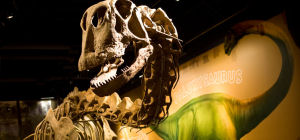
State Lone Star State Dinosaur: Paluxysaurus jonesi
Fort Worth Musuem: DinoLabs & DinoDig®
Texas Law
Paluxysaurus jonesi was designated the official lone star state dinosaur by House Concurrent Resolution and is, therefore, not listed in the Texas Statutes.
Only a small number of Texas' myriad symbols have been actually adopted by an act of the legislature and written into the Texas Statutes.
Sources...
"House Concurrent Resolution No. 16." Texas Legislature Online. The State of Texas, 2009. Web. 13 Oct 2011. .
"Senate Concurrent Resolution No. 57." Texas Legislature Online. The State of Texas, 1997. Web. 25 Feb 2011. .
Shearer, Benjamin F. and Barbara S. State Names, Seals, Flags and Symbols: A Historical Guide Third Edition, Revised and Expanded. Westport, Conn: Greenwood Press, 3 Sub edition, 2001.
Additional Information
Learn About Texas Dinosaurs :
The Texas Parks and Wildlife Department. Published in 2001 before identification of Paluxysaurus jonesi.
:
The Texas Parks and Wildlife Department. Published in 2001 before identification of Paluxysaurus jonesi.
Dinosaur Valley State Park: Texas Parks and Wildlife Department.
World's first skeletal mount of Paluxysaurus jonesi reveals new biology: Southern Methodist University Research.
Dinosaurs Alive!: The Fort Worth Museum of Science and History.
Paleobiology Database: Paluxysaurus jonesi: The Paleobiology Database is a public resource for the global scientific community. It has been organized and operated by a multi-disciplinary, multi-institutional, international group of paleobiological researchers.
State dinosaurs: Complete list of official state dinosaurs from NETSTATE.COM.
More symbols & emblems: Complete list of official Texas state symbols from NETSTATE.COM.
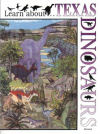
Learn About
Texas Dinosaurs
Georg Zappler
Learn About Texas Dinosaurs, by Georg Zappler. 48 pages. Publisher: Texas Parks and Wildlife Press; Revised edition (October 2001) Reading level: Ages 4-8. This popular colouring-and-activity book for lower-elementary-school-age children has been revised to include four recently discovered Texas dinosaurs. The dinosaurs are grouped by the time during which they lived, and each species and its habitat are illustrated with black-and-white line drawings. Fact boxes present the salient facts about each dinosaur-size, where found, classification, and main characteristics-and a time line shows when it lived.

Dinosaur Hunt
Karen Carr
Dinosaur Hunt: Texas-115 Million Years Ago, by Karen Carr. 48 pages. Publisher: HarperCollins (October 8, 2002) Reading level: Ages 5-10. On a muddy riverbank, a hungry dinosaur stalks her prey. From her hiding place in the nearby trees, she spies a giant, four-legged plant eater. At the right moment, she leaps from the trees and lunges at the slower dinosaur, tearing at its flanks with teeth and sharp claws.
It's an average day in southern Texas, 115 million years ago.
This dinosaur attack happened. We know for certain, because these two animals left their footprints in the mud -- and they're still there, hardened into stone for all to see. Dinosaur Hunt presents this dramatic event and brings the two combatants vividly back to life. It is the tale of a young Acrocanthosaurus, a predatory dinosaur similar to T. rex. As she grows she learns to hide, hunt, and survive in the eat-or-be-eaten age of dinosaurs.
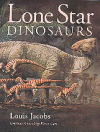
Lone Star Dinosaurs
Louis Jacobs
Lone Star Dinosaurs, by Louis Jacobs. 176 pages. Publisher: Texas A&M University Consortium Press (May 1, 1999) Some 111 million years ago, deep in the heart of Texas, a herd of twenty-ton dinosaurs sauntered across a wet mud flat. Their footprints eventually became frozen in stone, leaving a sign of one fleeting moment of a particular day in the lives of these magnificent creatures.
Today, after mountains of time have passed, the story of dinosaurs in what is now Texas is being reconstructed, footprint by footprint, bone by bone. Lone Star Dinosaurs tells that story, along with the exciting tale of the discoveries that have opened a peephole into the past. Behind each fossil find, there is not just a dinosaur but a person-- sometimes a child--whose spark of curiosity lights the picture of prehistory. This is a thrilling story, engagingly written and beautifully illustrated, through which young and old alike can enter the world of the dinosaurs and the world of the dinosaur hunters.

Discover Texas Dinosaurs
Charles E. Finsley
Discover Texas Dinosaurs: Where They Lived, How They Lived, and the Scientists Who Study Them, by Charles E. Finsley and Dr. Wann Langston, Jr. 150 pages. Publisher: Taylor Trade Publishing (March 1, 1999) Through photos and narrative, some of Texas' most dedicated scientists show you actual specimens of dinosaur material found in Texas, as well as dinosaur exhibits found throughout the state.
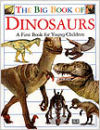
Big Book
of Dinosaurs
The Big Book of Dinosaurs: A first book for young children, 32 pages. Publisher: DK CHILDREN (September 1, 1994) Reading level: Ages 5-8. The Big Book of Dinosaurs is an enticing collection of dinosaurs that is sure to excite any child. It is packed with full-color photographs of life-like models plus detailed illustrations. The simple text describes interesting features, while questions encourage children to compare various dinosaurs.
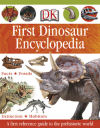
First Dinosaur
Encyclopedia
Catherine Bingham
First Dinosaur Encyclopedia, by Catherine Bingham. 128 pages. Publisher: DK CHILDREN (December 18, 2006) Reading level: Ages 6-12. From the first sea mammals to fierce dinosaurs, this inspiring reference book takes children on a fantastic journey into the prehistoric world.
New vocabulary and exciting facts inspire children to discover more--Quiz bars on every page make learning interactive and fun.

The Dinosaur Museum
The Dinosaur Museum, by The National Geographic Society. 24 pages. Publisher: National Geographic Children's Books; Pop edition (October 28, 2008) Reading level: Ages 6-10. Young, eager paleontologists wanted. Apply within. We need YOUR expertise! So step inside The Dinosaur Museum, the book where kids get to act like paleontologists. This amazing volume gives readers a behind-the-scenes peek at a museum, with an interactive experience that evokes a visit to a natural history museum. Forget about waiting in long lines for hours. This interactive guide takes you on a room-by-room tour of the most fun-packed museum you can imagine. Learning about prehistoric monsters becomes a practical challenge to the scientist in every reader. Each room points to a range of interactive investigations that can be carried out in the dino-lab gatefold flap. You can open the specimen drawer filled with fossils, look at specimen slides through the microscope, and use a whole host of interactive features: a pop-up fossil finds maps, a dinosaur time line, and a sliding chart that allows you to compare the size of dinosaurs with modern animals.
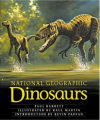
National Geographic
Dinosaurs
Paul Barrett
National Geographic Dinosaurs, by Paul Barrett. 192 pages. Publisher: National Geographic Children's Books; 1st edition (October 1, 2001) Reading level: Ages 8+. Dramatic illustrations and vivid text reveal the latest facts, field findings, and theories on how these prehistoric creatures most likely looked, behaved, and interacted. Spectacular paintings depict various dinosaurs in their habitats while scientifically-based anatomical paintings profile 53 major types of dinosaurs. A wealth of current scientific thought on the dinosaur-bird connection and profiles of feathered dinosaurs are included.
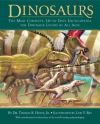
Dinosaurs
Thomas R. Holtz
Dinosaurs: The Most Complete, Up-to-Date Encyclopedia for Dinosaur Lovers of All Ages, by Dr. Thomas R. Holtz Jr. 432 pages. Publisher: Random House Books for Young Readers (October 23, 2007) Reading level: Young Adult. Written by a professional paleontologist specifically for young readers, this guide to the Dinosauria is packed with enough detail and insider information to satisfy even die-hard dinophiles! The text includes brief entries on all 800+ "named" species of Mesozoic dinosaurs, as well as chapters on the history of dinosaur discoveries, the science of dinosaur art, dinosaur biology, and much more. With sidebars by 33 world-famous paleontologists, museum-quality illustrations, and over 20 never-beforeseen restorations of new dinosaur species, this is a must-have compendium of fact and fandom that dino enthusiasts of all ages will devour with glee!
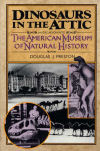
Dinosaurs
in the Attic
Douglas J. Preston
Dinosaurs in the Attic: An Excursion into the American Museum of Natural History, by Douglas J. Preston. 256 pages. Publisher: St. Martin's Griffin (November 15, 1993) Dinosaurs in the Attic is a chronicle of the expeditions, discoveries, and scientists behind the greatest natural history collection every assembled.
Written by former Natural History columnist Douglas Preston, who worked at the American Museum of Natural History for seven years, this is a celebration of the best-known and best-loved museum in the United States.

